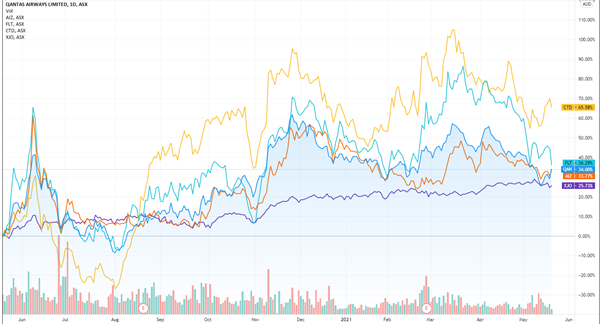The Qantas Airways Ltd [ASX:QAN] share price lift as market update points to domestic recovery and balance sheet repair.
Qantas shares today jumped as high as 4.8% in early trade before settling to trade for $4.68 per share at time of writing, up 3.5%.
The Qantas share price was as a low as $2.36 during the March 2020 trough, but the market’s forward-looking nature propelled the QAN stock higher as investors priced in an eventual recovery.
Over the last 12 months, Qantas gained 30%, outperforming the ASX 200 benchmark by 7%.
Qantas path to recovery
In today’s market update, the national airliner pointed to its continued recovery on the back of a rebound in domestic travel demand and its Freight and Loyalty divisions.
QAN’s recovery thesis was backed by its expectation that, on current market conditions, it will be statutory free cash flow positive for the second half of FY21.
Qantas also revealed ‘strong’ liquidity levels with total funds available totalling $4 billion as of 30 April 2021. This includes cash of $2.4 billion and $1.6 billion in undrawn debt facilities.
Nonetheless, lingering COVID ramifications mean the company projects total revenue loss since the start of the pandemic to reach $16 billion by FY21.
That said, Qantas also forecasts to be underlying EBITDA positive in the range of $400–450 million for FY21.
The forecast rests on there being no further lockdowns or significant domestic travel restrictions.
Despite the projected positive underlying EBITDA, Qantas still expects a statutory loss before tax in excess of $2 billion.
‘Resilient’ domestic travel
Qantas revealed that domestic travel is ‘proving more resilient compared with earlier in the pandemic.’
Corporate travel is now at 75% of pre-COVID levels, up from 65% in April.
Leisure demand is ‘growing strongly’, with customers converting deferred international holidays into multiple domestic trips.
Importantly, Qantas thinks it is on track to reach 95% of its pre-COVID domestic capacity in 4Q21.
The conversion of international trips to domestic ones is expected to help Qantas and Jetstar reach 107% and 120% of pre-COVID domestic capacity in FY22.
The growing demand means Qantas and Jetstar have brought all their domestic aircraft back into service.
Looking at the airliner’s international operations, Qantas reported that the net cash cost of carrying its international division improved due to the trans-Tasman bubble and Freight flights, dropping from $5 million a week to $3 million a week.
What next for Qantas Share Price?
QAN’s publicly listed competitor Regional Express Holdings Ltd [ASX:REX] also saw its share price jump, gaining as much as 5% in early trade before retracing to be up 2% at time of writing.
Webjet Ltd [ASX:WEB] and Flight Centre Travel Group Ltd [ASX:FLT], however, are currently both down more than 4%.
This could partly be explained by the fact that Qantas will seek to change its commission arrangements for travel agents.
From July next year, travel agents will only be paid 1% commission instead of the current rate of 5%.
The share price action divergence could also reflect the contrasting fortunes of domestic and international travel demand.
Released on Wednesday, Webjet’s FY21 results saw all its business segments report ‘significant falls’.
And despite Webjet OTA and Online Republic bookings picking up in 2H21 as domestic markets opened, Webjet’s key international markets remained heavily impacted with large-scale restrictions still in place ‘in most regions.’
REX and Qantas, on the other hand, skew heavily towards the domestic market.
For instance, in Fy19, Qantas Domestic and Jetstar together contributed $1,110 million in underlying EBIT. Qantas International contributed $285 million.
QAN’s domestic sales are so prominent partly because of its market share dominance in Australia.
It has more than 70% market share and recently even poached more than 30 business accounts from rival Virgin.
Its cost cutting program coupled with a rebounding domestic market contributed to 11 analysts covering Qantas stock to forecast $3.6 billion in EBITDA in 2023.
According to consensus forecasts by S&P global Market Intelligence, ‘aviation analysts and Qantas true believers are looking through the temporary hit to earnings from the pandemic to the other side when the company will be approaching record profits.’
Inflation fears are on the up. Growth stocks are seeing red. FUD attacks are making cryptocurrencies even more volatile. And interest rates continue to languish at near zero.
How can an investor wade through this environment?
If you’re seeking insight into this question while also looking out for real value, I’d recommend checking out Greg Canavan’s Life at Zero presentation.
He outlines how persistent low rates can flush cash into the market and the ways in which you can invest based on this.
It’s an insightful analysis of a potential future ‘cash panic’ and I highly recommend listening to what he has to say.
Regards,
Lachlann Tierney,
For Money Morning
PS: Our publication Money Morning is a fantastic place to start on your investment journey. We talk about the big trends driving the most innovative stocks on the ASX. Learn all about it here



Comments